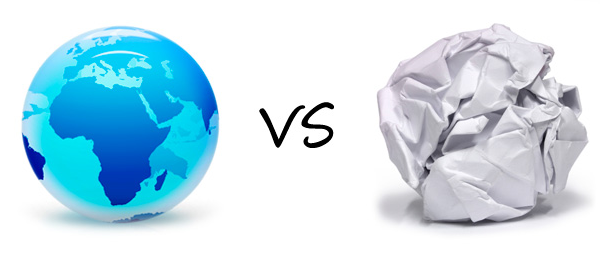5 Ways Print and Web Design Are Different

Reading and writing for the web, as opposed to print design, comes with its own challenges. One might be tempted to draw parallels between the two processes, but they are very different.

The biggest difference is that fonts that work well on paper can often be difficult to read when viewed on a computer. Also, because some web users make personal changes to their web browser font choices and defaults, there is no guarantee that when seeing a particular font on a web page it will look as clear or crisp as it does on paper.
Pages in print are stationary; static. After being printed, those who are reading and viewing the printed pages will see the graphics in the same location, text in the same font and size, and should someone, for example, pick up and crumple or wrinkle the print’s pages, the paper will not shrink to a smaller size. It stays the same in every respect. On the other hand, web pages flow more effortlessly, and they tend to be more vibrant. In terms of control and ease of use, web pages and their content allow the viewer to control how they actually view a page, completely separate from what the web designer may have intended.
Even though web pages might utilize certain elements descended from print, the experience is altogether different. When you go to a website and scroll through their pages, you will undoubtedly notice the use of text columns, like they might use in a booklet printing, but they are not used in the same fashion a book or other printed work will make use them. For example, the format of the table of contents of a book is a shared element between web design and print, but other column-oriented layouts will appear much different in print than on the web. This can be attributed to a web page’s web-like construction, where fonts, text and formatting will appear different, not only because of a web designer’s preferences, but also due in large part to the ability of web surfer to customize how they see a particular page.
CMYK is the color format of choice for commercial printers, but other color options can be made use of. Pantone spot colors are also a viable option when trying to settle upon a color format. Conversely, web designers use RGB color formatting. This is sometimes a problematic choice simply because you need to accommodate browser-friendly color arrays, but this is not a typical experience. Typography differs between web design and print, and this is a result of the readability considerations inherent on a computer screen compared to a printed page of paper.
It is obvious, even to the greenest of web or print designers that the technological advantages afforded by web design allow for a more dynamic experience in design when compared to print. Software, such as Adobe Photoshop, have so many creative options at the designer’s disposal that when stacked up against the more traditional printing methods, print falls short of the mark. That being said, not everyone, especially those using traditional printing methods, needs so many creative options in their arsenal.
